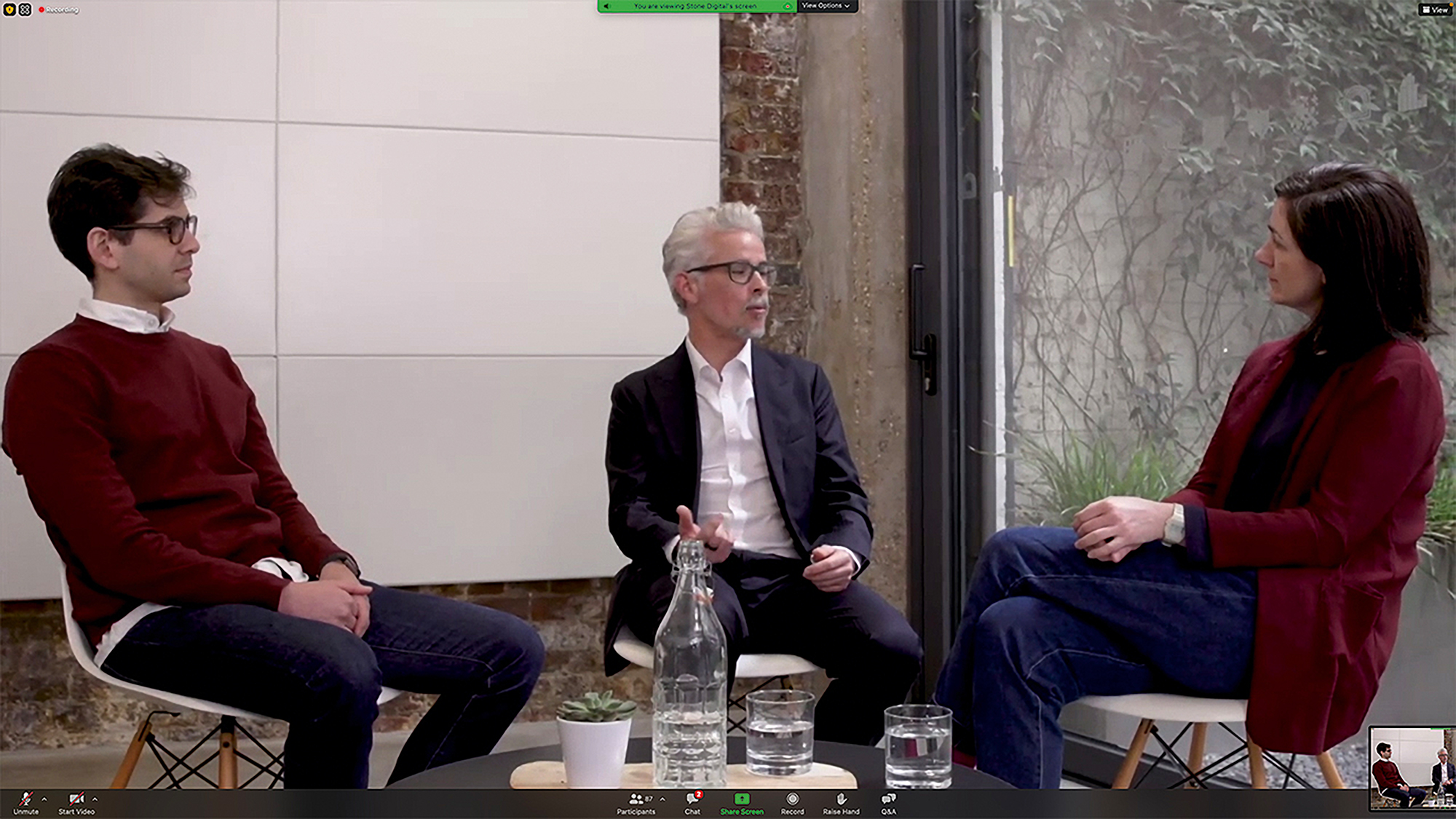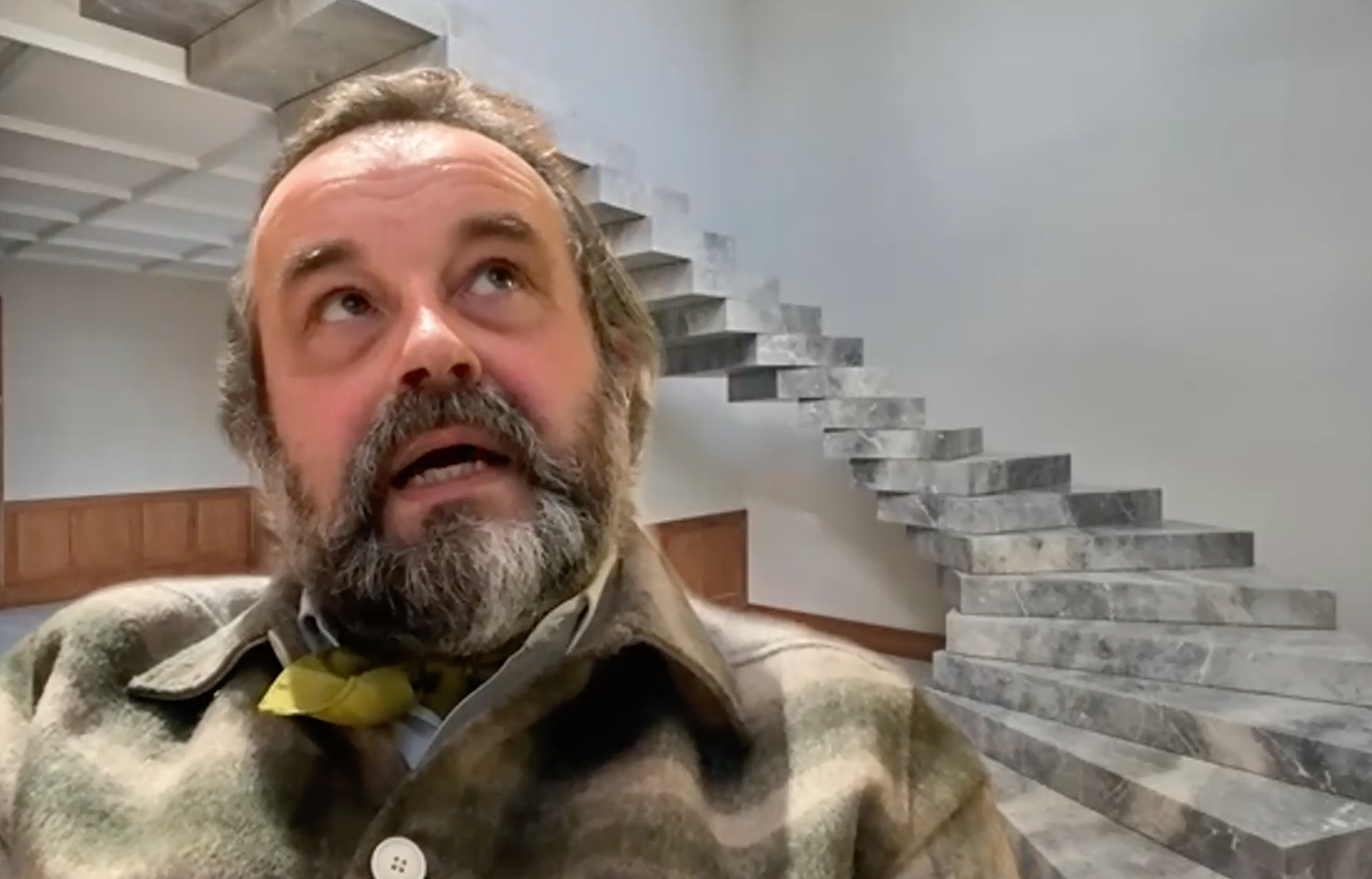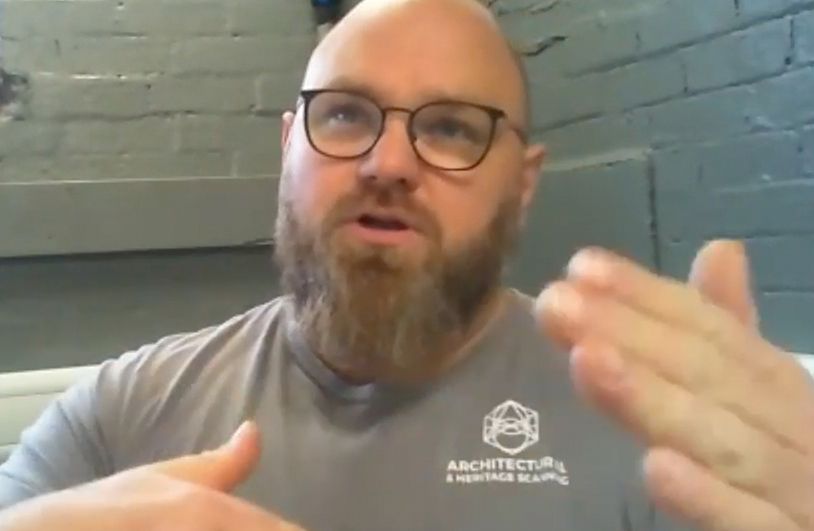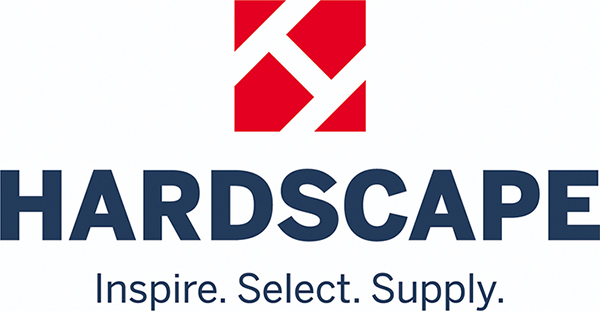With the UK committed to Net Zero greenhouse gas emissions by 2050, stone, as a zero carbon raw material, has a natural advantage over other building materials. Stone Digital was a ground-breaking event for the industry to spread that message.
In a world committed to reducing greenhouse gas (GHG) emissions a raw material like stone that has a zero carbon footprint should have a natural advantage. But the fragmented industry that supplies dimensional stone products lacks the multi-billion pound international companies of sectors such as concrete, steel and glass to champion its cause. As a result, its message can be hard to hear amid the clamour of every other sector to emphasise their green credentials.
It is amazing how, given a sufficient budget, a concrete company’s claim to have cut its carbon emissions by 30% can sound more impressive than a stone company’s message that its products always have been low carbon.
The Stone Digital – Shaping a Sustainable Future conference held online on 22 & 23 February was a ground-breaking attempt by the stone industry to get its message heard.
And with a good measure of success, with some 845 people getting involved on the days. It is expected the number who watch the presentations will top the 1,000 mark now recordings are available on catch-up at bit.ly/SD-on-demand.
The Stone Digital event was staged by the organisers of the Natural Stone Show & Hard Surfaces, normally held every other year at ExCeL London but, like other exhibitions around the world, cancelled because of Covid. The Natural Stone Show is due to return to ExCeL with Hard Surfaces 18-20 April next year.
Stone Digital, like the Natural Stone Show itself, was supported by this magazine as media partner and Stone Federation Great Britain, which has launched its own series of webinars called The Case for Stone to further spread stone’s message.
Stone Digital – Shaping a Sustainable Future covered a wide area of the use of stone in architecture, including new build, heritage, landscaping and interiors.
Many of the presentations also made it clear just how much the march of digitalization has accelerated during the restrictions imposed by the Covid pandemic. It was a subject specifically addressed in the final session of the eight presented during the two days of the event.
It became clear during the presentations that digitization is already playing a significant part in increasing the productivity of the stone industry and construction in general and can only take a growing role in improving communications and reducing waste going forward.
We also heard during the presentations how stone companies are reducing their carbon footprints still further – because although they are using a zero carbon raw material, there are GHG-emitting processes involved in extracting the material, processing it and transporting it.
Low energy transformation
Most of the processes involved in transforming blocks of stone into usable masonry for building and materials for flooring, surfaces, cladding, walling and hard landscaping basically involve sawing and in some cases polishing, either with electrical machinery or by hand, either of which can involve relatively low carbon energy, especially with electricity generation increasingly moving to renewable sources.
Any building material has to be moved to site, of course, and transport is a major producer of GHGs, but we heard from speakers about how this is being tackled with the use of electrically-powered vehicles and the substituting of diesel with biofuels. We heard from primary stone producers Albion Stone and Polycor that in the latest Euro Six heavy plant engines, diesel and biofuels can be used without the engines needing adjustments. Biofuels still emit CO2 but only half as much as diesel.
Nick Wilson of specialist contractor Stonewest pointed out that diesel is sometimes not allowed to be left on-site on projects overnight these days. As it is not feasible to empty the tanks of generators and machines every night and refill them in the morning, biofuels are used instead.

Frances Gannon, a Partner at Make Architects (right), talks with Lefteris Siamopoulos, Senior Façade Consultant at FMDC (left), and Darren Anderson, Director & Stone Consultant at FMDC, during the opening session of the Stone Digital conference.
Stone Digital began with Simon Sturgis, the founder of Targeting Zero, setting the scene by putting global warming into context. He explained that for the past 800,000 years the CO2 level in the air has fluctuated between 200 and 300 parts per million (ppm) in roughly 100,000 year cycles of ice ages and warmer periods.
However, since 1780, the start of the industrial revolution, that level has been rising at an unprecedented rate and has now reached 418ppm. That is blamed for the temperature of the earth already having increased by 1ºC above the pre-industrial level.
That, in turn, is blamed for changes in weather patterns that have led to forest fires, floods and increasingly ferocious gales, which is why countries around the world are working together under the Paris Agreement to keep global warming to below 2ºC above the pre-industrial level, and preferably at no more than 1.5ºC.
In the UK, the government has committed to reducing the level of carbon emissions to 100% below the 1990 base-line and be 68% towards that target by 2030. That requires action by everyone, both in their business and private lives.
Dr Flavie Lowres, who used to work at the BRE but in October last year set up her own business called Green Thinking and also works for the Alliance for Sustainable Building Products as an embodied carbon advisor, explained how schemes such as BREEAM, for classifying the environmental impact of buildings, could help cut the carbon footprint of the built environment.
Frances Gannon, a Partner at Make Architects, led a discussion with Lefteris Siamopoulos and Darren Anderson from FMDC, a façades and materials design consultancy. They have analysed the carbon footprint of building materials because, as Darren said, “it’s assumptions that are dangerous”.
They agreed natural stone is a gift, with zero embodied carbon and sustainable because the crust of the planet on which we live is stone. Darren said: “In terms of reserves in the world, it’s calculated there are sufficient reserves for millions of years to come.”
He said Environmental Product Declarations (EPDs) are the equivalent of nutrition values (calories, salt, sugar and so on) shown on food. Clients and specifiers are expecting to see EPDs on building materials.
During the following two days of Stone Digital there was much talk and many examples of the sustainable use of stone, including its contribution to a circular economy through its re-use.
Nick Wilson, a Director of specialist contractor Stonewest, spoke about how Stonewest was re-using stone in retained façades, which could involve reducing the thickness of the stone for re-attachment to a new building in the same location. The stone removed would be stored and re-used, either in other areas of the same building or on other buildings.
Robert Greer, a Director of specialist PAYE Stonework & Restoration, presented the case of PAYE’s reinstatement of the Aston Webb Screen at the V&A museum in London. The screen had been dismantled some years earlier and kept in storage. It was then to be rebuilt as a gated entrance.
Access was created between the columns that had previously been filled with Portland limestone. The stone that had been removed was then used as street furniture in Exhibition Road, facing the museum.
Prior to PAYE repurposing the British Portland stone for street furniture, the plan had been to use Indian granite. Re-using the Portland clearly had a lower carbon footprint than bringing stone from India, with the travel involved in driving it hundreds of miles from the quarry to the docks and then shipping it thousands of miles to London.
There was more about the use and re-use of stone in the heritage sector, where there are many stone buildings, in the session headed ‘Sustainable solutions for our built heritage’.
Because of the difficulty of transporting heavy blocks of stone in earlier centuries, historically, buildings tended to use whatever was to hand, although in the south of England that does include French limestone, especially after the Norman invasion of 1066, because it was easy to bring from France in ships and France was sometimes closer than alternative sources of stone from England.
The Building Stone Database for England
Identifying the original source of stones used in historic buildings is not always easy, but Clara Willett, Senior Building Conservation Adviser at Historic England, said help is at hand from the Building Stone Database for England, which is the final product of the Strategic Stone Study to identify quarry sites and some of the property built from the stone from those quarries.
The Strategic Stone Study entered the information gathered on a Geological Information System (GIS) map (which can be accessed free at bit.ly/buildingstone). A GIS has different layers of information that can be explored.
The map has been produced by the British Geological Survey in Nottingham, with the first information being entered in 2007 and the project being considered completed this year, when it will be launched as the Building Stone Database for England. A set of publications relating to the information gathered will be published by Historic England.
Dr Stephen Parry from the British Geological Survey provided further advice on selecting the right stone for conservation projects at Stone Digital.
The Building Stone Database for England has identified more than 4,000 quarry sites, 12,000 reference buildings and 19,000 historic stone structures, although Clara said information would continue to be added as it came to light. She said the map is widely referenced in local authority planning documents.
Planning was another aspect covered by Stone Digital, with Sam Thistlethwaite, Director of IC Planning, explaining what mandatory design codes mean for the use of natural stone and Nic Shannon, Managing Director of Domus Façades, talking about the benefits of sustainable stone cladding brought about by the recent revision of BS 8298.
Primary stone producers Albion Stone, which mines Portland limestone, and Polycor, with quarries in North America and France, spoke about their moves to reduce the already small carbon footprint of their operations.
Michael Poultney, the Managing Director of Albion Stone, said his company’s journey towards net zero had begun 25 years ago when he realised that to obtain planning permission to be able to continue to extract stone from Portland he would have to end opencast production and start mining. Since then he has obtained the environmental management standard ISO 14001 and achieved an ‘Excellent’ rating for BES 6001, the Responsible Sourcing for Construction Products standard, as well as producing an EPD.
Polycor, meanwhile, has committed to achieving Net Zero by 2025. Bryan Thorburn, Director of Business Development Europe & The Middle East, explained how the company is achieving that. In a video he showed as part of his presentation, Patrick Perus, Polycor’s Chief Executive Officer, says: “This is not corporate BS. We are doing it. We are doing it for sure. This is the future of the construction industry.”
There was a session specifically devoted to hard landscaping, with Steintec, Hardscape and Fila demonstrating how they are helping the environment and reducing their carbon emissions. They also addressed the subject of the use of stone in sustainable drainage schemes (SuDS), which is usually associated with concrete, and Steve Burton, Technical Director of Steintec, spoke about the latest version of BS 7533, published last year, with just one part (101) replacing seven parts of the standard as it was previously.
Much of the granite and sandstone used in hard landscaping comes from the Far East, a lot of it from India, where there is still modern slavery and child labour, which was another issue addressed by Stone Digital. David Richardson, Director of Diagenesis Consulting, explained how the Ethical Stone Register can help stone companies to demonstrate their efforts to tackle modern slavery.
Tamsin Pickeral, Operations Director of stone contractor Szerelmey, explained the company’s journey to the second ‘verification’ level on the Ethical Stone Register and Steve Walley, the Managing Director of London Stone, spoke about his part in the No Child Left Behind initiative to get children out of quarries and into schools.
There was talk in various sessions about returning to using stone in its traditional form as load bearing masonry, an example of which was shown by Pierre Bidaud, Creative Director of The Stonemasonry Company in Ketton, in Rutland. The Stonemasonry Company is particularly famous for its stunning staircases, but it also produces architectural stone and worked with architect Amin Taha and engineer Steve Webb to supply the structural stone exoskeleton of 15 Clerkenwell Close in Islington, London. The exoskeleton is famously constructed of blocks with sawn and split faces straight from the quarry.

Pierre Bidaud of The Stonemasonry Company. Behind him is one of his company’s stone staircases. He said stone can be threaded on a steel skewer, "like a stone kebab", to make use of stone that would otherwise be waste.
Pierre Bidaud: “It’s all about commodity. Stone is a commodity. Stone was used as just a pure building material. Unfortunately, in the past 30-40 years it’s been used just as a cladding, a veneer, and we believe stone should be much more than that – go back to basics and build with it.”
Stone as commodity
Pierre called on architects to accept much more variety in the stone they use, encompassing and celebrating the nature of stone rather than trying to eliminate it.
He said: “It’s all about commodity. Stone is a commodity. Stone was used as just a pure building material. Unfortunately, in the past 30-40 years... it’s been used just as a cladding, a veneer, and we believe stone should be much more than that – go back to basics and build with it.”
Pierre also showed examples of more conventional structural stone elsewhere in the world, as well as explaining the use of pre and post tensioning to create the oh-so-elegant, gravity-defying staircases The Stonemasonry Company makes.
The structural use of stone was a subject also covered by James Simpson, OBE, consultant with Simpson & Brown Architects and Chairman of the Building Limes Forum, while David Wilson, Architectural Consultant at cladding specialist Shackerley, spoke about the benefits of lightweight cladding reducing the amount of material required for the frame of buildings and so reducing the carbon footprint of the structure as a whole.
A recurring theme throughout the conference was the use of technology. For example, Dr Mohamed Abdel-Wahab, Senior Lecturer at the University of the West of Scotland, and Dr Scott McGibbon, Director of PvoTAL Consultancy, had spoken about it in terms of its benefits for the heritage building sector.
It was a subject that Stone Digital returned to as it concluded its two-day run, with Mark Dellar, Business Unit Leader of Vetter UK, talking about the connected contractor; Robert Merry, of Stone Consultants, exploring the digital route to sustainable construction; Graham Sykes, Technical Director of Architectural & Heritage Scanning, explaining how surveys using lasers, point clouds and 3D views help understand buildings; and James Weston, Plant Controller at Natural Stone Surfaces in Derbyshire, and Director David Roy explaining how they have adopted lean manufacturing from the automotive industry for the worktop market, digitally connecting templating to design, production, customer communications and installation.

Robert Merry of Stone Consultants: “At the end of the day, finally and ultimately, we’re going to have to have somebody who actually fits the stone on site, and I don’t think that’s ever going to change.”
That’s just a quick run through the topics covered by the 34 speakers who contributed to Stone Digital. And we should not forget the significant contribution from Susannah Streeter, a leading broadcaster and sustainability commentator, who anchored the whole event, providing theme-setting introductions to each session and putting questions posted by the audience to the speakers after their presentations. She also led panel discussions that rounded off each session.
Hopefully this review has whetted your appetite to listen to some of the presentations. They are certainly worth your time and will help to get the stone message out into the wider construction industry, promoting the use of this inherently low carbon, sustainable material being offered by an industry playing its part in tackling global warming and improving the productivity of construction.

Graham Sykes of Architectural & Heritage Scanning: “We have used the same render techniques and the same navigation methods that are used in the gaming world for displaying 3D models.”







